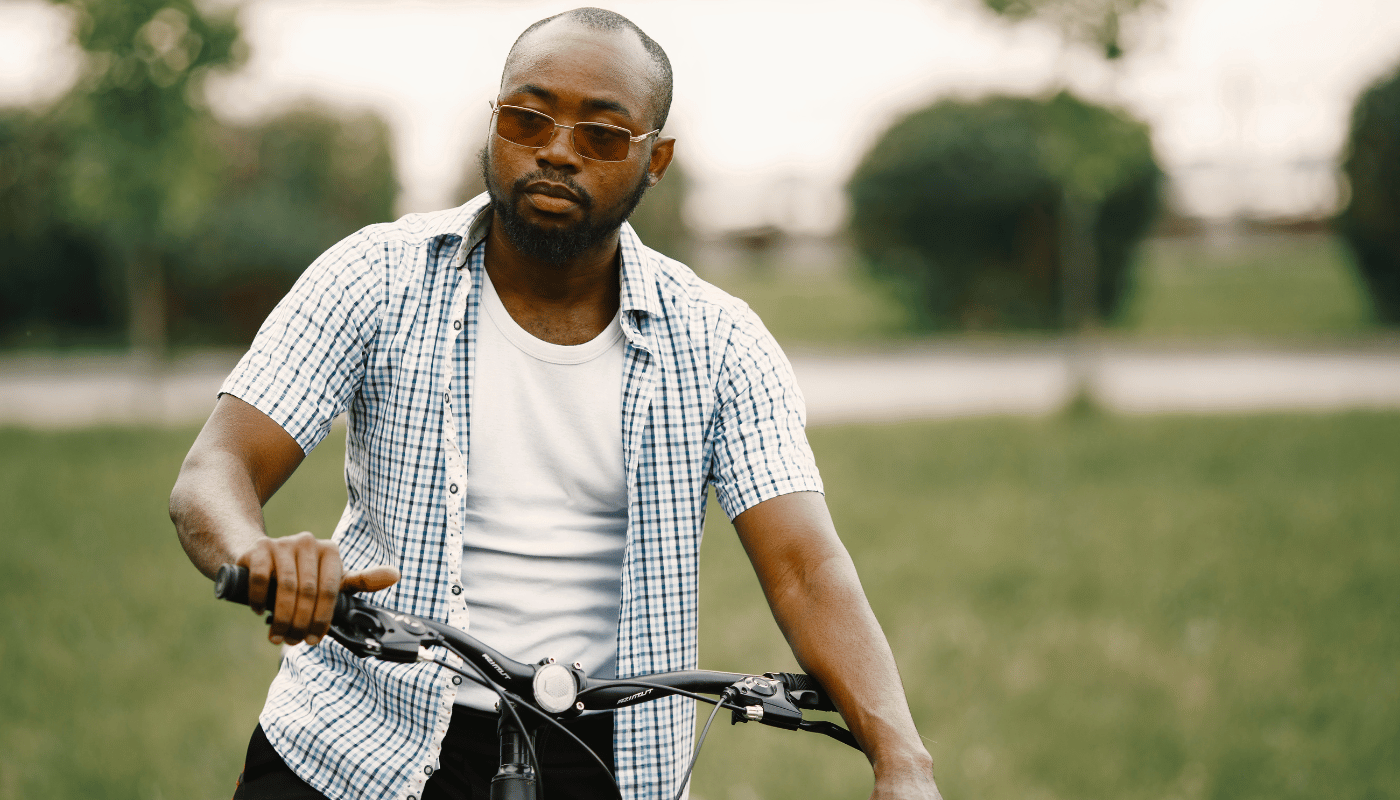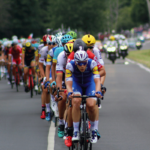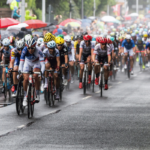1. You’re Not as Small as Others, Don’t Try to Ride Like One
I’ve always been big. That’s why I played basketball. I have had to learn to dodge objects in ceilings other people don’t even see. I’ve had to realize that most items produced for purchase are too small for me. Like outlet bicycles. Cyclists are small people. Fabian Cancellara (186 cm) and Tom Boonen are in the big boy league (190 cm), but they weigh around 80 kg. Most of the riders are in the horse jockey area of tiny people of between 160-180 cm like Lance Armstrong.
My ride buddy Maarten is in the optimum height/weight range for cycling and for a long time I tried to keep up with him. I didn’t level the playing field to my advantage and my panting and my heart rate monitor was squealing like a banshee, telling me to not die. The first step to becoming a better big boy cyclist is to realize that you are a large fellow (or lady) and you will have to ride accordingly.
2. You Consume More Energy, Remember to Refill
Maarten can survive with just sucking bone marrow.
If you have a large engine in your car, it will use more fuel. The same applies to people. The larger the person, the more drag they create, the more energy they consume, even if they wouldn’t do anything. If you have to move 130 kilos instead of 90 kilos, you will burn through more energy. Most energy bars and gels and bananas are designed for the average Joe, so you might not get enough energy even if your skinny mate would. It’s better to overdo it in the beginning, because no one has died for having too much energy in them.
I started with being safe. I split the trip into parts and fed accordingly. Especially in the beginning I was wasting a lot of energy and a few times I ran out, which made the last trek quite hard. After starting to fill up my reserves on schedule based on the amount traveled, I’ve been able to do much more and finally did my metric century as well.
3. Descend Like an Eagle
Even if you’re coming down a hill.
Finnish cyclists have a saying: “Extra mass equals extra power.” Physicists would say that more mass means more potential energy, since power is specifically a unit of work per time.
This is important for us big people. We have one advantage in cycling; we can roll faster and longer in any descent, thanks to our mass. The next time you’re riding behind someone and see a long descent awaiting followed by a long ascent, don’t stay hanging behind the skinny guys. They’re better climbers than you are, so blaze past them, use your mass to roll in far and hard, maximize your approach and use that velocity to climb the hill, saving important energy.
It’s good to learn to really push it on the descent, pedal up to as high as you can without exerting yourself. My average speed might be the same as my co-riders, but my peaks are 15-20 km/h higher than theirs.
4. Climb Like a Gorilla
Even if you have to carry it.
The previous statement of mass and power, or as our dear friend Albert Einstein Isaac Newton put it into his 2nd law “F equals ma,” applies quite universally. Even in cycling. If you have extra mass and you want to go faster (have extra velocity), you will need extra power to reach said velocity. This applies even more to climbing, and I am being smoked every single ascent I’m riding with my lither friends. For a long time I just assumed that I’m not as fit as they are and tried harder every time, only to fail miserably.
Trying to keep up with fast climbs creates a problem of burning through way too much energy, and while you might be able to climb once or twice, after four your whole ride will start slagging, you will run out of energy and riding will not be fun anymore. Instead, I’ve learned to get ahead by descending fast and then climbing like a gorilla, slowly but steadily. I’ll be able to catch my mates soon enough. Especially dangerous for people like me are double climbs, where a climb is immediately followed by another one. If I try to tackle them together with friends, I’ll end up dead.
In short, keep climbing steadily at a pace you can maintain. Work your gears also to the other direction; if you try to pedal with too small a gear, you will just waste energy. When you get the speed up in the ascent, gear up and keep pedaling.
Climbing can be learned through repetition, so you can get better, but if you’re just starting out, climbing like a gorilla will help a lot.
5. Drink Like a Camel
An animal that drinks often, a fish.
Drinking is just like eating; it varies by person. Still, as with eating, the larger you are, the more you need. You also have more mass to keep hydrated, because you have a larger area available for sweating. Drinking enough liquids with proper electrolytes to help you hydrate will keep you riding for longer.
Not drinking will cause cramps and no one wants those. Drinking plain water will just make you want to pee. We’ve already written a long post on keeping your hydration levels functional during a ride, so go read it after you’ve read this one. (You can find it here.)
Simple rules from that article: Don’t wait until you’re thirsty, one liter of water per hour (minimum), get electrolytes in your drink and keep on drinking. (Update: It was pointed out that camels drink a lot rarely, we want you to drink a little often.)
6. Don’t Overdress
Me after a gentlemen’s ride (or my wedding).
Did you know that a human will output from around 70 watts to 870 watts as body heat, depending on the amount of physical activity undertaken?
Usually, the larger the animal, the better it can handle temperatures since they have bigger muscles to produce heat with. As a rule of thumb, small-bodied animals or plant parts (e.g., leaves) heat up and cool down faster; bigger and/or thicker bodies heat up and cool down slower, just like small cookies cool faster than massive ones.
This means that if you’re a big person, you will also warm slower but stay warmer for longer. This can cause problems with overdressing, causing your body to try to cool itself, burning through your precious energy and liquids as sweat pours through your glands. If you’re hot when you start the ride, you’re way overdressed. You should be a bit chilly or cool when you start your trip; that’ll guarantee better performance in the long run.
Wear breathable materials and as little as possible. Don’t wear big, bulky packs or other bags that cover large areas of your body. The more is covered, the less your body can breathe. If you get cold, put some more effort and warm yourself back up. This applies even to winter climates and temperatures. We have a group of (crazy) Finns who go jogging wearing just shorts and sneakers when the temperature is in the negative double digits.
Invest in layers instead of thick fabrics, like a gilet (a bike vest) with a windbreaker front and an open mesh in the back.
7. Get the Right Size Bike Frame
Most bikes are designed for the average user, as usual. Most people also have too small bikes, especially us big ones. You can’t imagine the difference I had when I moved from an almost right size to the right size bike. Even though the frame geometry might be only a few degrees there or a few millimeters here, it can and usually does make the difference.
No shopkeeper can tell you what size frame you should have. They can give you a starting point, but then it’s up to you to try, test, and tweak to find the best size bike for you. Good shopkeepers from your local bike shop will help you select and find the right frame, the right material, and other parts necessary to have you on the bike correctly. Also, remember that when you start riding on a bike, you will sit and stand on it differently; it will change over time. Discomfort in the beginning that turns to pleasure is better than the other way around.
Also, remember that no frame is identical, especially between different manufacturers. Some are always big and long (like Surly), some are always small (like Cube). So a 58 cm frame from one company might be bigger than a 62 cm frame from another.
But trust me, the frame alone is never enough.
It’s also good to get the right type of bike, so we wrote an article about that too: 5 Questions in Choosing the Right Bike.
8. Set Up the Rest of Your Bike Properly
Once you have found a frame and a bike that are really good for you, it’s time to make it better. A bike is basically just a compilation of parts, and most of them change the ride geometry somehow. Changing parts to find the ultimate riding posture is not only easy but also quite cheap.
People are special, unique, and different in their measurements. You might be really tall but not have wide shoulders. Some people are naturally flexible, while others are stiff. Expecting all people to fit the same geometry is madness. If the handlebars are too wide for you, the brake handles too far from your fingers, or your seat post makes you crouch too much, change it.
One great example of making a difference is the crank set. People have different leg lengths, even tall people. The more natural the circular motion while pedaling, the more efficiency you can get out of every push. Clipless pedals help even more. Again, most bike parts in factory bikes are made for “normal” people, so change them.
Doing this after you’ve ridden a few hundred kilometers on your bike will give you better results as your body gets used to the ride. Check where your hands naturally place and put a stem that makes your hands stand on the brake covers. Talk to your LBS and tune your ride.
9. Measure Your Speed, Cadence, and Heart Rate
The better you know your body, the better you can make it work. Learning to pedal your cranks at a regular pace (or cadence) that you can control is the best tool for saving energy and helping your body learn your natural pace. A smaller gear allows you to propel your bike forward with less energy required, and you won’t have to stress your thighs to constantly push and push, but instead you will roll and glide on your pedals.
Understanding speed is also a bit different when endurance cycling; it’s a lot like running a marathon, only with a bike and a longer distance – but the time spent on the activity is pretty much the same. We usually average at about 25 kilometers per hour, meaning that we can ride 100 kilometers in four hours. That’s a good pace, not too stressful and not too lax even. Your current speed doesn’t tell you anything, you can see it later – but the important thing is your average speed. That’s a goal you can increase easily.
Knowing your heart rate helps most in your gorilla climbing. Big people usually have bigger and stronger muscles because the muscles are used to bear a larger load (i.e., you). I see a lot of big boys pumping their big muscles, pushing their way forward. This will wear you out. If you are using too large a gear, you might be working with your thighs constantly and that will end up in cramps even with the best of them. Keep your heart rate and activity below the threshold where your muscles produce lactic acid. Eventually, you can let your muscles relax and recover even during your ride, allowing you to use that power when it is really needed.
There are several ways to measure these three. Heart rate is the easiest; since the more your heart has to work, the more oxygen it needs, the more you need to breathe. If you can talk comfortably while riding (or exercising in general), you are working at low intensity. If you have difficulties talking because of your breathing, you’re in the medium intensity range, and if you’re panting and out of breath, you’re definitely working in the high-intensity area. This applies to all people. Better fitness means a bigger range in the low and medium areas, and less need to go to the high intensity.
Cadence is all about rhythm. Count seconds in your mind (one-mississippi, two-mississippi) and count how often you pedal and try to keep it at the same pace. When you get the hang of that, improve. Note that increasing cadence makes your heart work much more, so your heart rate will go up. Don’t worry, this is normal and is great for training.
Your speed is hard to measure without tools, but it’s also the least important of these measurements. Measuring also gives you a better insight into time and your progress, so I’ve found personally that spending a hundred bucks on a heart rate monitor is a good investment for all, especially us big people. But all in all, cycling and all exercise is about having fun; no tools are needed!
10. Take Baby Steps
If you can ride 10 kilometers, you can ride 20. If you can ride 20 kilometers, you can ride 40. If you can ride 40 kilometers, you can ride 80. If you can ride 80 kilometers, you can ride. The hardest thing is getting started. But I will guarantee you that if you follow these steps, you can reach your goal very quickly – a few months even if you are not completely out of shape.
It took me a month to start riding 50 km trips, which in turn quite quickly led me to ride my first 100 km ride. But I had to start at 10 kilometers, go up to 25, then up to 45, then 75, and then 100. Riding a metric century is never a trifle; it’s a lot of work, you spend thousands of calories, drink a gallon of water, and you will feel sore afterward, just like with any long ride.
Remember, resting is just as important as the actual activity. If you don’t allow your muscles and body to recover from the stress, they will not develop; instead, they will just start conserving energy. We actually wrote a post about fighting fatigue to keep on cycling too a few years back, so take a look!
Conclusion
Cycling is not just a physical activity but also a personal journey of overcoming challenges. As a larger cyclist, you face unique hurdles, but these can also provide you with distinct advantages. Apply the knowledge you’ve gained to adjust your technique and training approach, and always celebrate your achievements. Cycling can be demanding, but it is also immensely rewarding. Stay patient and persistent, and you will see your efforts pay off. Every mile, every improvement, and every obstacle overcome is a step towards your personal success. Keep riding, enjoy the process, and remember: the path to mastery begins with the first pedal stroke.





